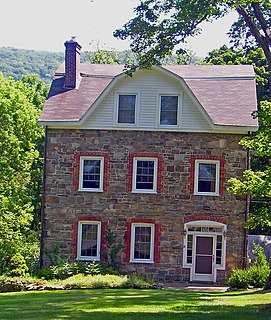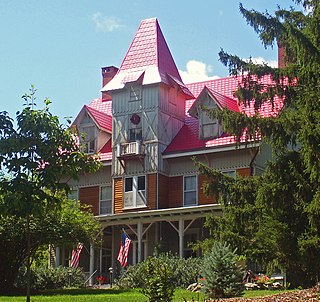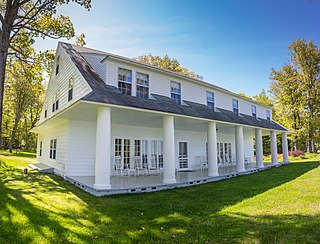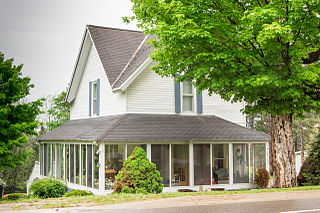Patrick Piggot House | |
 House in 2007 | |
| Location | Cornwall, NY |
|---|---|
| Nearest city | Newburgh |
| Coordinates | 41°25′40″N74°02′30″W / 41.42778°N 74.04167°W Coordinates: 41°25′40″N74°02′30″W / 41.42778°N 74.04167°W |
| Built | 1869 [1] |
| Architect | Mead and Taft [1] |
| Architectural style | Queen Anne |
| NRHP reference # | 98001115 |
| Added to NRHP | 1998 |
The Patrick Piggot House, also known as Angola Lodge, is located on Angola Road just east of US 9W in Cornwall, New York, United States. It has gone from being a farmhouse to a summer boardinghouse back to a private dwelling once again.
U.S. Route 9W (US 9W) is a north–south U.S. Highway in the states of New Jersey and New York. It begins in Fort Lee, New Jersey, as Fletcher Avenue crosses the US 1–9, US 46, and the Interstate 95 (I-95) approaches to the George Washington Bridge, and heads north up the west side of the Hudson River to US 9 in Albany, New York. As its "W" suffix indicates, US 9W is a westerly alternate route of US 9 between the two locations. US 9W directly serves three cities—Newburgh, Kingston, and Albany—and enters the vicinity of several others. As the route heads north, it connects to several highways of regional importance, including I-84, US 209, New York State Route 23 (NY 23), and US 20. Much of US 9W parallels the New York State Thruway and NY 32; additionally, the latter overlaps with US 9W in four different locations.

Cornwall is a town in Orange County, New York, United States. As of the 2010 census, the population was at 12,646. Cornwall is located about 50 miles north of New York City in the Hudson River Valley on the western shore of the Hudson River. Cornwall has become a bedroom community for area towns and cities including New York City. Commuter rail service to North Jersey and New York City is available via the Salisbury Mills–Cornwall train station, operated by NJ Transit in behalf of Metro-North Railroad that is part of Metro-North's "West of the Hudson" service. The town is located less than an hour from the George Washington Bridge with access to major commuter routes like the New York State Thruway and the Palisades Parkway.

New York is a state in the Northeastern United States. New York was one of the original thirteen colonies that formed the United States. With an estimated 19.54 million residents in 2018, it is the fourth most populous state. In order to distinguish the state from the city with the same name, it is sometimes referred to as New York State.
Piggot and his wife Ellen bought the property from local landowner Henry Chedeayne in 1869. That summer they contracted with Mead and Taft to build a farmhouse. They designed a simple Queen Anne home, less ornate than the Cornwall house that later became popular novelist Amelia Barr's Cherry Croft summer home. It had two storeys and a cross-gabled roof. [1]

In the United States, Queen Anne-style architecture was popular from roughly 1880 to 1910. "Queen Anne" was one of a number of popular architectural styles to emerge during the Victorian era. Within the Victorian era timeline, Queen Anne style followed the Stick style and preceded the Richardsonian Romanesque and Shingle styles.

Amelia Edith Huddleston Barr was a British novelist and teacher. Her career is an illustration of the capacity of woman under stress of sorrow to conquer the world and be successful. Many of the plots of her stories are laid in Scotland and England. The scenes are from her girlhood recollection of surroundings. Her works include, Jan Vedder's Wife, The Border Shepherdess, Feet of Clay, Friend Olivia, The Bow of Orange Ribbon, Remember the Alamo, She Loved a Sailor, A Daughter of Fife, The Squire of Sanddal Side, Paul and Christina, Master of His Fate, The, Household of McNeil, The Last of the Macallisters, Between Two Loves, A Sister to Esau, A Rose of a Hundred Leaves, A Singer from the Sea, The Beads of Tasmer, The Hallam Succession, The Lone House, Christopher and Other Stories, The Lost Silver of Briffault.
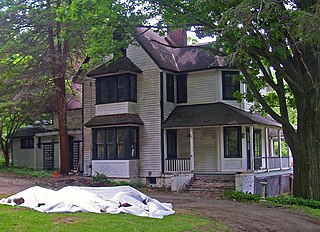
The Amelia Barr House, also known as Cherry Croft, is located on Mountain Road in Cornwall on Hudson, a village in Orange County, New York, United States. It is on the slopes of Storm King Mountain, near Storm King School. Barr, the most published American female writer born in the 19th century, lived here during the most prolific and successful period of her career.
They and their seven children worked on the family farm until 1910, when the Chedeayne estate foreclosed on them after they failed to pay their mortgage. In 1916 it was sold to a Miriam Williams, who renovated and modified it slightly and then in turn sold it to Max Meyers. He found the house perfect for adaptation into a summer boardinghouse. The wide floors offered enough space for guest rooms and their symmetrical windows encouraged light breezes through the house. [1] Downtown Cornwall and the Hudson Highlands were located short walks away.

Foreclosure is a legal process in which a lender attempts to recover the balance of a loan from a borrower who has stopped making payments to the lender by forcing the sale of the asset used as the collateral for the loan.

A mortgage loan or, simply, mortgage is used either by purchasers of real property to raise funds to buy real estate, or alternatively by existing property owners to raise funds for any purpose, while putting a lien on the property being mortgaged. The loan is "secured" on the borrower's property through a process known as mortgage origination. This means that a legal mechanism is put into place which allows the lender to take possession and sell the secured property to pay off the loan in the event the borrower defaults on the loan or otherwise fails to abide by its terms. The word mortgage is derived from a Law French term used in Britain in the Middle Ages meaning "death pledge" and refers to the pledge ending (dying) when either the obligation is fulfilled or the property is taken through foreclosure. A mortgage can also be described as "a borrower giving consideration in the form of a collateral for a benefit (loan)".
Adaptive reuse refers to the process of reusing an existing building for a purpose other than which it was originally built or designed for. Adaptive reuse is an effective strategy for optimizing the operational and commercial performance of built assets. Adaptive reuse of buildings can be an attractive alternative to new construction in terms of sustainability and a circular economy. Not every old building can qualify for adaptive reuse. Architects, developers, builders and entrepreneurs who wish to become involved in rejuvenating and reconstructing a building must first make sure that the finished product will serve the need of the market, that it will be completely useful for its new purpose, and that it will be competitively priced.
Angola Lodge peaked in the 1930s and '40s, after which vacationers began preferring shorter vacations located further away. Eventually it was sold and restored to its original use. The original windows and many of the original interior remains. [1] It was added to the National Register of Historic Places in 1998.

The National Register of Historic Places (NRHP) is the United States federal government's official list of districts, sites, buildings, structures and objects deemed worthy of preservation for their historical significance. A property listed in the National Register, or located within a National Register Historic District, may qualify for tax incentives derived from the total value of expenses incurred in preserving the property.







